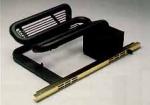Search engine visitors - click here to access entire "$ensible Home" web site
Click here to see a descriptive illustration of a heat-circulating grate, chimney pillow, glass doors, fireback, etc.
Dear Jim: I know most fireplaces waste energy, but we love to sit in front of a raging fire. Are there any simple, low-cost things we can do to make it produce heat and to reduce the smoky smell in the room? - Thomas M.

A: People seldom realize the typical wood-burning fireplace sucks more heat out of a house than it produces. This makes the furnace run longer and drives up utility bills. Even though you feel toasty warm directly in front of the flames, the rest of the house gets very chilly.
There are several simple things you can do to make your fireplace much more efficient and change it into an overall energy producer and money saver for your home. Many of the same improvements also help reduce smoky conditions.
The two key improvements are: 1) reducing the amount of already-heated room air lost up the chimney and 2) directing more heat from the fire out into the room. By running your furnace blower on continuous air circulation, the heated air in the fireplace room will be distributed throughout your house.
The most heated room air is lost up chimneys when there is no fire burning because of a nonexistent or poor sealing chimney damper. To seal the chimney and provide insulation, I use an inflatable chimney pillow in my fireplace. It is clear plastic and you blow it up like a mini-air mattress.
Another option to block room air lost is a tight-sealing damper assembly that is mounted on top of the chimney with silicon caulking. Long narrow cables hang down in the chimney to easily open and close the damper. Chimney exhaust fans also seal well and can eliminate a smoky fireplace condition.
Tight-fitting glass fireplace doors with adjustable air openings help when the fire is burning. Some doors use magnets and others use cams to keep them tightly closed. High-temperature silicon gaskets provide an excellent seal. Polished nickel, copper and pewter finishes are very attractive.
Install a heat circulating grate in the fireplace. The grate is made of steel pipes with a built-in fan that draws cool room air in one side and blows heated air out the other. The base is only 1.5 inches high so it fits under the glass doors. The heat output is as high as 40,000 Btu per hour.
Models with a built-in thermostat and a variable-speed blower provide the most control over the heat output and the sound level. The thermostat turns the blower on automatically at 110 degrees and off at 90 degrees.
A heavy cast iron plate (fireback), placed in the back of the fireplace, gets very hot. This helps radiate more of the fire's heat out into the room before it is lost up the chimney. Many have decorative patterns cast into the face.
Instant Download Update Bulletin No. 553 - buyer's guide of 14 manufacturers of energy efficient and decorative glass fireplace doors, heat-radiating firebacks, inflatable chimney pillows, chimney covers, chimney fans, chimney damper/draft fans, heat-circulating grates showing heat outputs, sizes, features, tips for a clean, efficient fire and fireplace safety along with illustrations with descriptions of several products.
Dear Jim: I have to install a new roof soon and I was wondering if the color really makes any difference. Also, is there a type of paint that can be used to change the color of a roof without replacing it? - Gene W.
A: The color of the shingles does make a difference in the amount of heat gain during the summer. During the winter, the impact of color is less. Very light-colored shingles are the best for energy efficiency.
There are several types of paint that are specifically made for roofs. Check your paint store. Ceramic-filled roof paint is probably the most effective at rejecting the sun's intense heat during the summer.